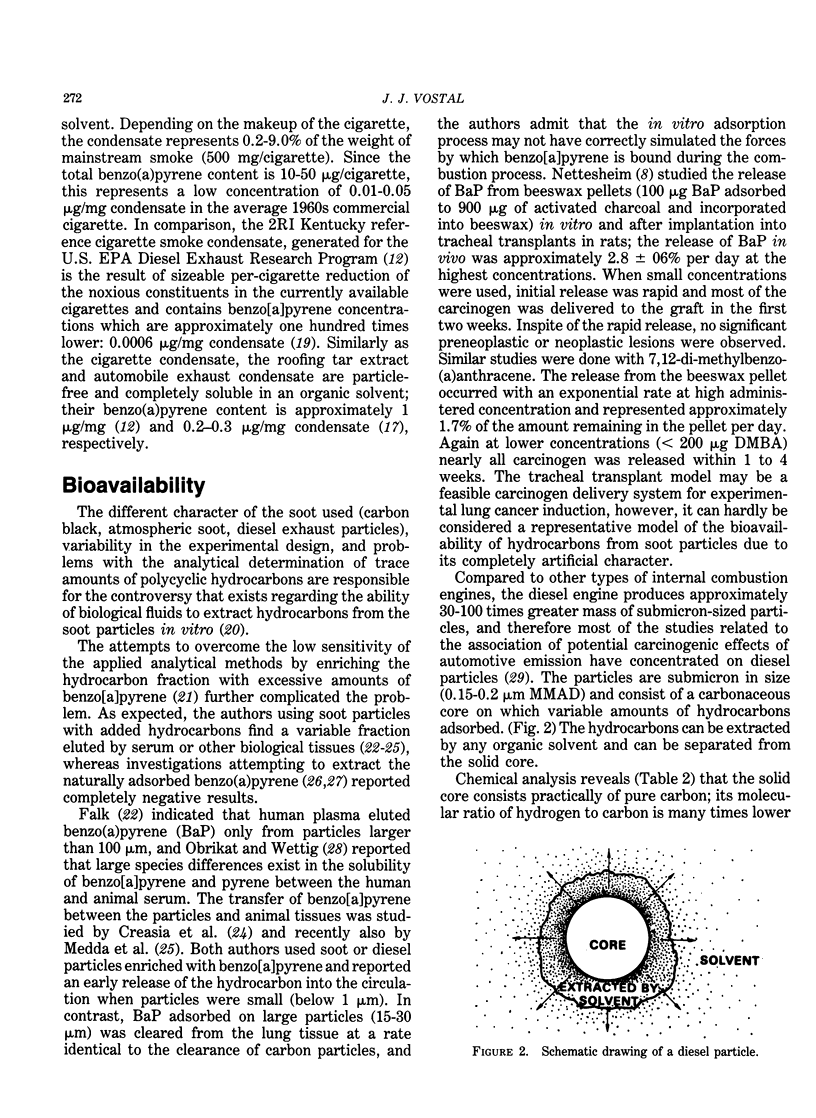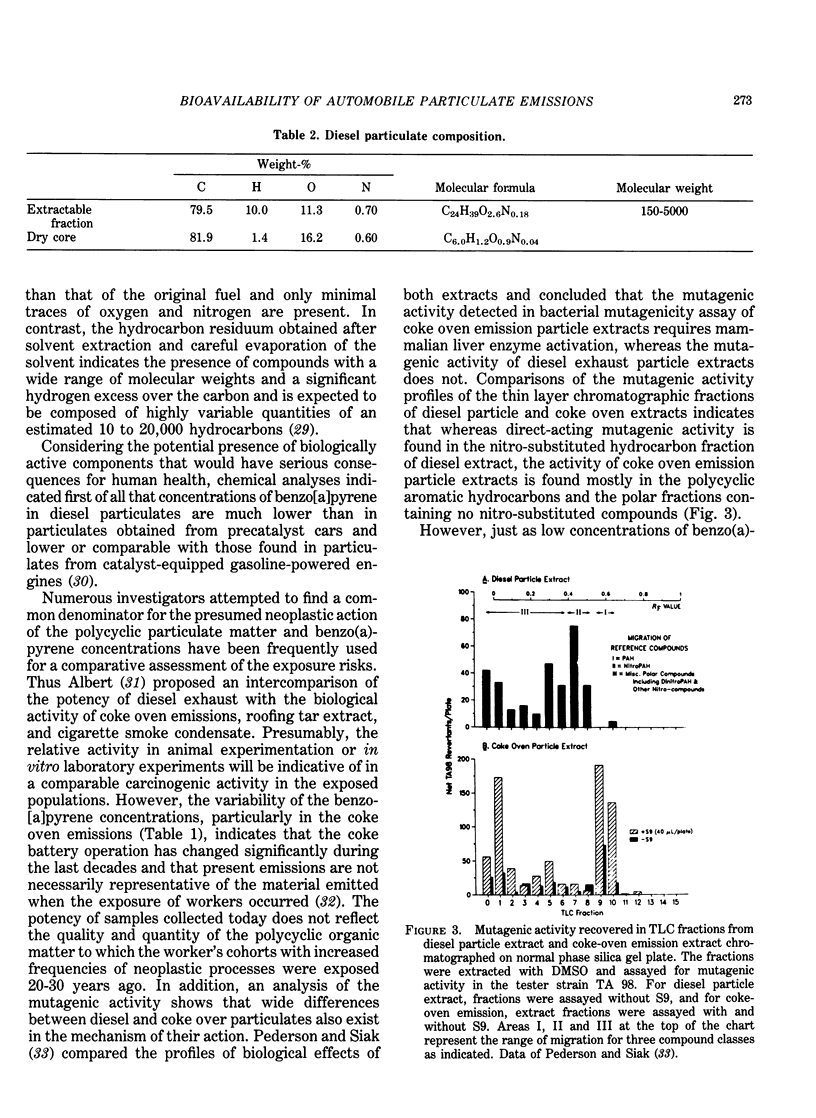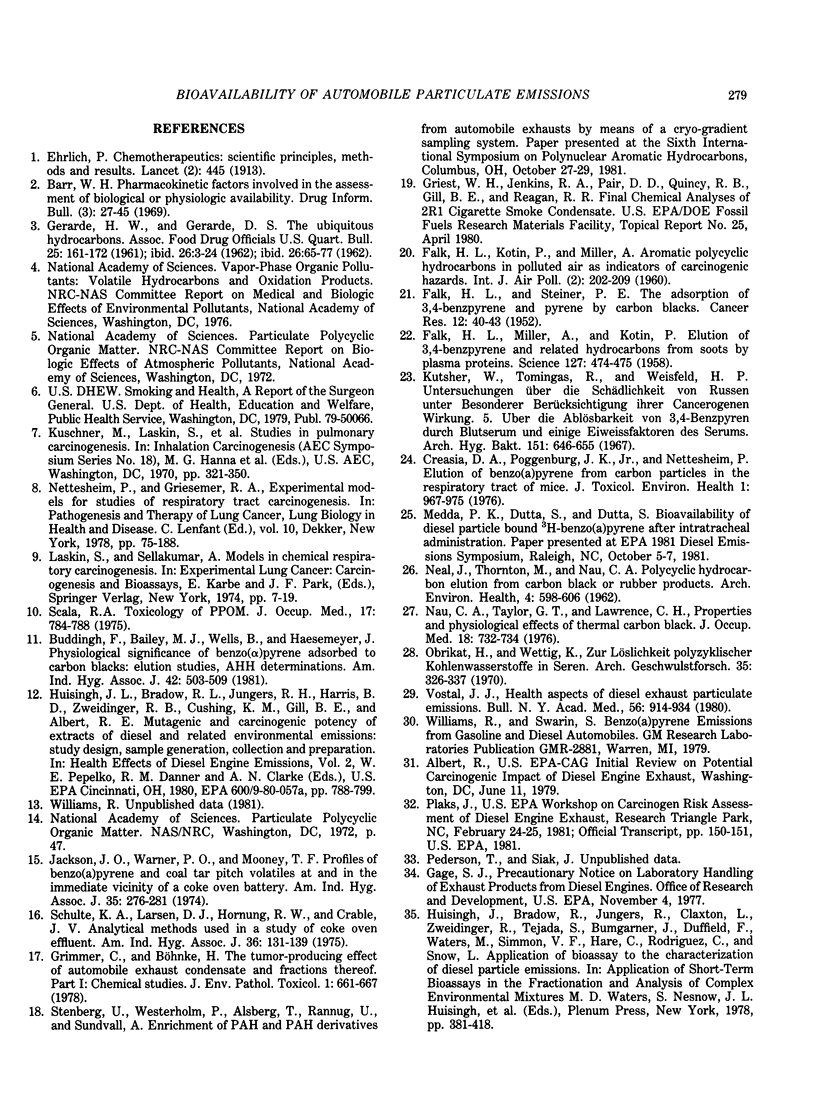Abstract
The pharmacokinetic concepts of bioavailability and biotransformation are introduced into the assessment of public health risk from experimental data concerning the emissions of potentially mutagenic and carcinogenic substances from motor vehicles. The inappropriateness of an automatic application in the risk assessment process of analytical or experimental results, obtained with extracts and procedures incompatible with the biological environment, is illustrated on the discrepancy between short-term laboratory tests predictions that wider use of diesel engines on our roads will increase the risk of respiratory cancer and the widely negative epidemiological evidence. Mutagenic activity of diesel particulates was minimal or negative when tested in extracts obtained with biological fluids, was substantially dependent on the presence of nitroreductase in the microbial tester strain, and disappeared completely 48 hr after the diesel particles had been phagocytized by alveolar macrophages. Similarly, long-term animal inhalation exposures to high concentrations of diesel particles did not induce the activity of hydrocarbon metabolizing enzymes or specific adverse immune response unless organic solvent extracts of diesel particles were administered intratracheally or parenterally in doses that highly exceed the predicted levels of public exposure even by the year 2000. Furthermore, the suspected cancer producing effects of inhaled diesel particles have thus far not been verified by experimental animal models or available long-term epidemiological observations. It is concluded that unless the biological accessibility of the active component on the pollutant as well as its biotransformation and clearance by natural defense mechanisms are considered, lung cancer risk assessment based solely on laboratory microbial tests will remain an arbitrary and unrealistic process and will not provide meaningful information on the potential health hazard of a pollutant.
Full text
PDF












Selected References
These references are in PubMed. This may not be the complete list of references from this article.
- Bast R. C., Jr, Shears B. W., Rapp H. J., Gelboin H. V. Aryl hydrocarbon (benzo(alpha)pyrene) hydroxylase in guinea pig peritoneal macrophages: benz(alpha)anthracene-induced increase of enzyme activity in vivo and in cell culture. J Natl Cancer Inst. 1973 Aug;51(2):675–678. [PubMed] [Google Scholar]
- Buddingh F., Bailey M. J., Wells B., Haesemeyer J. Physiological significance of benzo(alpha)pyrene adsorbed to carbon blacks: elution studies, AHH determinations. Am Ind Hyg Assoc J. 1981 Jul;42(7):503–509. doi: 10.1080/15298668191420152. [DOI] [PubMed] [Google Scholar]
- Cantrell E. T., Warr G. A., Busbee D. L., Martin R. R. Induction of aryl hydrocarbon hydroxylase in human pulmonary alveolar macrophages by cigarette smoking. J Clin Invest. 1973 Aug;52(8):1881–1884. doi: 10.1172/JCI107371. [DOI] [PMC free article] [PubMed] [Google Scholar]
- Cantrell E., Busbee D., Warr G., Martin R., Anderson M. D. Induction of aryl hydrocarbon hydroxylase in human lymphocytes and pulmonary alveolar macrophages--a comparison. Life Sci. 1973 Dec 16;13(12):1649–1654. doi: 10.1016/0024-3205(73)90112-4. [DOI] [PubMed] [Google Scholar]
- Chen K. C., Vostal J. J. Aryl hydrocarbon hydroxylase activity induced by injected diesel particulate extract vs inhalation of diluted diesel exhaust. J Appl Toxicol. 1981 Apr;1(2):127–131. doi: 10.1002/jat.2550010213. [DOI] [PubMed] [Google Scholar]
- Creasia D. A., Poggenburg J. K., Jr, Nettesheim P. Elution of benzo[alpha]pyrene from carbon particles in the respiratory tract of mice. J Toxicol Environ Health. 1976 Jul;1(6):967–975. doi: 10.1080/15287397609529398. [DOI] [PubMed] [Google Scholar]
- Dziedzic D. Differential counts of B and T lymphocytes in the lymph nodes, circulating blood and spleen after inhalation of high concentrations of diesel exhaust. J Appl Toxicol. 1981 Apr;1(2):111–115. doi: 10.1002/jat.2550010210. [DOI] [PubMed] [Google Scholar]
- FALK H. L., KOTIN P., MARKUL I. The disappearance of carcinogens from soot in human lungs. Cancer. 1958 May-Jun;11(3):482–489. doi: 10.1002/1097-0142(195805/06)11:3<482::aid-cncr2820110308>3.0.co;2-v. [DOI] [PubMed] [Google Scholar]
- FALK H. L., KOTIN P., MILLER A. Aromatic polycyclic hydrocarbons in polluted air as indicators of carcinogenic hazards. Int J Air Pollut. 1960 Mar;2:201–209. [PubMed] [Google Scholar]
- FALK H. L., MILLER A., KOTIN P. Elution of 3,4-benzpyrene and related hydrocarbons from soots by plasma proteins. Science. 1958 Feb 28;127(3296):474–475. doi: 10.1126/science.127.3296.474. [DOI] [PubMed] [Google Scholar]
- FALK H. L., STEINER P. E. The adsorption of 3,4-benzpyrene and pyrene by carbon blacks. Cancer Res. 1952 Jan;12(1):40–43. [PubMed] [Google Scholar]
- FOUTS J. R., BRODIE B. B. The enzymatic reduction of chloramphenicol, p-nitrobenzoic acid and other aromatic nitro compounds in mammals. J Pharmacol Exp Ther. 1957 Feb;119(2):197–207. [PubMed] [Google Scholar]
- Grimmer G., Böhnke H. The tumor-producing effect of automobile exhaust condensate and fractions thereof. Part I: chemical studies. J Environ Pathol Toxicol. 1978 May-Jun;1(5):661–667. [PubMed] [Google Scholar]
- Harris J. O., Swenson E. W., Johnson J. E., 3rd Human alveolar macrophages: comparison of phagocytic ability, glucose utilization, and ultrastructure in smokers and nonsmokers. J Clin Invest. 1970 Nov;49(11):2086–2096. doi: 10.1172/JCI106426. [DOI] [PMC free article] [PubMed] [Google Scholar]
- Heath D., Smith P., Hasleton P. S. Effects of chlorphentermine on the rat lung. Thorax. 1973 Sep;28(5):551–558. doi: 10.1136/thx.28.5.551. [DOI] [PMC free article] [PubMed] [Google Scholar]
- Jackson J. O., Warner P. O., Mooney T. F., Jr Profiles of benzo(a)pyrene and coal tar pitch volatiles at and in the immediate vicinity of a coke oven battery. Am Ind Hyg Assoc J. 1974 May;35(5):276–281. doi: 10.1080/0002889748507034. [DOI] [PubMed] [Google Scholar]
- Jett J. R., Moses H. L., Branum E. L., Taylor W. F., Fontana R. S. Benzo(a)pyrene metabolism and blast transformation in peripheral blood mononuclear cells from smoking and nonsmoking populations and lung cancer patients. Cancer. 1978 Jan;41(1):192–200. doi: 10.1002/1097-0142(197801)41:1<192::aid-cncr2820410128>3.0.co;2-0. [DOI] [PubMed] [Google Scholar]
- Kellermann G., Cantrell E., Shaw C. R. Variations in extent of aryl hydrocarbon hydroxylase induction in cultured human lymphocytes. Cancer Res. 1973 Jul;33(7):1654–1656. [PubMed] [Google Scholar]
- King L. C., Kohan M. J., Austin A. C., Claxton L. D., Huisingh J. L. Evaluation of the release of mutagens from diesel particles in the presence of physiological fluids. Environ Mutagen. 1981;3(2):109–121. doi: 10.1002/em.2860030203. [DOI] [PubMed] [Google Scholar]
- Kutscher W., Tomingas R., Weisfeld H. P. Untersuchungen über die Schädlichkeit von Russen unter besonderer Berücksichtigung ihrer concerogenen Wirkung. 5. Uber die Ablösbarkeit von 3,4-Benzpyren durch Blutserum und einige Eiweisskaktoren des Serums. Arch Hyg Bakteriol. 1967 Nov;151(7):646–655. [PubMed] [Google Scholar]
- Li A. P. Antagonistic effects of animal sera, lung and liver cytosols, and sulfhydryl compounds on the cytotoxicity of diesel exhaust particle extracts. Toxicol Appl Pharmacol. 1981 Jan;57(1):55–62. doi: 10.1016/0041-008x(81)90024-7. [DOI] [PubMed] [Google Scholar]
- Löfroth G., Hefner E., Alfheim I., Møoller M. Mutagenic activity in photocopies. Science. 1980 Aug 29;209(4460):1037–1039. doi: 10.1126/science.6996094. [DOI] [PubMed] [Google Scholar]
- McLemore T. L., Martin R. R., Busbee D. L., Richie R. C., Springer R. R., Toppell K. L., Cantrell E. T. Aryl hydrocarbon hydroxylase activity in pulmonary macrophages and lymphocytes from lung cancer and noncancer patients. Cancer Res. 1977 Apr;37(4):1175–1181. [PubMed] [Google Scholar]
- NEAL J., THORNTON M., NAU C. A. Polycyclic hydrocarbon elution from carbon black or rubber products. Arch Environ Health. 1962 Jun;4:598–606. doi: 10.1080/00039896.1962.10663219. [DOI] [PubMed] [Google Scholar]
- Nau C. A., Taylor G. T., Lawrence C. H. Properties and physiological effects of thermal carbon black. J Occup Med. 1976 Nov;18(11):732–734. doi: 10.1097/00043764-197611000-00008. [DOI] [PubMed] [Google Scholar]
- Navarro C., Charboneau J., McCauley R. The effect of in vivo exposure to diesel exhaust on rat hepatic and pulmonary microsomal activities. J Appl Toxicol. 1981 Apr;1(2):124–126. doi: 10.1002/jat.2550010212. [DOI] [PubMed] [Google Scholar]
- Nebert D. W., Gelboin H. V. The in vivo and in vitro induction of aryl hydrocarbon hydroxylase in mammalian cells of different species, tissues, strains, and developmental and hormonal states. Arch Biochem Biophys. 1969 Oct;134(1):76–89. doi: 10.1016/0003-9861(69)90253-7. [DOI] [PubMed] [Google Scholar]
- Obrikat H., Wettig K. Zur Löslichkeit polyzyklischer Kohlenwasserstoffe in Seren. Arch Geschwulstforsch. 1970;35(4):326–337. [PubMed] [Google Scholar]
- Pederson T. C., Siak J. S. The activation of mutagens in diesel particle extract with rat liver S9 enzymes. J Appl Toxicol. 1981 Apr;1(2):61–66. doi: 10.1002/jat.2550010204. [DOI] [PubMed] [Google Scholar]
- Rosenkranz H. S., McCoy E. C., Sanders D. R., Butler M., Kiriazides D. K., Mermelstein R. Nitropyrenes: isolation, identificaton, and reduction of mutagenic impurities in carbon black and toners. Science. 1980 Aug 29;209(4460):1039–1043. doi: 10.1126/science.6996095. [DOI] [PubMed] [Google Scholar]
- Rudiger H. W., Kohl F., Mangels W., von Wichert P., Bartram C. R., Wohler W., Passarge E. Benzpyrene induces sister chromatid exchanges in cultured human lymphocytes. Nature. 1976 Jul 22;262(5566):290–292. doi: 10.1038/262290a0. [DOI] [PubMed] [Google Scholar]
- Scala R. A. Toxicology of PPOM. J Occup Med. 1975 Dec;17(12):784–788. [PubMed] [Google Scholar]
- Schulte K. A., Larsen D. J., Hornung R. W., Crable J. V. Analytical methods used in a study of coke oven effluent. Am Ind Hyg Assoc J. 1975 Feb;36(2):131–139. doi: 10.1080/0002889758507221. [DOI] [PubMed] [Google Scholar]
- Sims P., Grover P. L. Epoxides in polycyclic aromatic hydrocarbon metabolism and carcinogenesis. Adv Cancer Res. 1974;20:165–274. doi: 10.1016/s0065-230x(08)60111-6. [DOI] [PubMed] [Google Scholar]
- Smith P., Heath D., Hasleton P. S. Electron microscopy of chlorphentermine lung. Thorax. 1973 Sep;28(5):559–566. doi: 10.1136/thx.28.5.559. [DOI] [PMC free article] [PubMed] [Google Scholar]
- Taylor G. T., Redington T. E., Bailey M. J., Buddingh F., Nau C. A. Solvent extracts of carbon black--determination of total extractables and analysis for benzo(alpha)pyrene. Am Ind Hyg Assoc J. 1980 Nov;41(11):819–825. doi: 10.1080/15298668091425699. [DOI] [PubMed] [Google Scholar]
- Vostal J. J. Health aspects of diesel exhaust particulate emissions. Bull N Y Acad Med. 1980 Nov-Dec;56(9):914–934. [PMC free article] [PubMed] [Google Scholar]


